|
Ausbildung
des |
|
|
|
Ausbildung
des |
|
|
|
Training Station:
"Goldhöhe"
in Riesengebirge.
|
|
|
Training establishment, "Goldhöhe", 1942-45 In October 1943 Knoespel had discussed with Nusser the idea that a training school should be set up in Germany where those who volunteered for meteorological expeditions to the Arctic might learn something of the art of travel and of living in polar regions. Official approval was obtained without difficulty, and Knoespel was appointed to take charge of the project. A group of disused army huts on the Goldberghöhe in the Riesengebirge was chosen as the site for the school, the official title of which was Ausbildungsstation Goldhöhe. Assisted by Heinrich Schatz, Knoespel began to instruct and select the volunteers for the operations planned for the following year; not only were the uninitiated taught how to adjust themselves to polar conditions, but equipment and clothing were tested to determine their suitability for arctic operations. Later, when Operation "Holzauge" returned from East Greenland, the captured Danish huskies were sent to Goldhöhe for instructional purposes. In the autumn of 1943 Knoespel and Schatz were relieved by Weiss, Dege and Rieche, assisted by mountaineers K. Schmid and W. Sander. It is admitted, somewhat ruefully, that mistakes were made in the training. For example, it was decided that during the period of instruction, those taking part should be required to eat tinned and dehydrated foods in order to accustom them to field fare; in practice this policy defeated its own object, as it merely gave the victims a premature distaste for their future nourishment. In May 1944 the course at Goldhöhe closed with a brief visit to the Mountain Warfare School at Fulpmes [Hochgebirgskampfschule Fulpmes] near Innsbrück. A very profitable feature of this visit was a concentrated 10-days course in medicine and practical surgery in which three or four members of each expedition "qualified". Wilhelm Dege, who led Operation "Haudegen", 1944-45, has related how expeditions gradually took shape at Goldhöhe: "On or about 10 May 1944 training came to an end. Meanwhile, in the round of daily work and comradeship of communal life, the members of the three intended expeditions had already combined of their own free will. The meteorologists and their assistants, wireless operators etc., joined themselves voluntarily to the scientist whom they wished to accompany, who was to lead an expedition, while the scientists who were to be leaders had the opportunity to refuse men who appeared to them to be unsuitable, and to undertake any exchange arrangements which seemed necessary in order to ensure that in all technical, military and administrative matters each party would be able to look after itself. After this mutual selection of leaders and members the director of the naval meteorological service formally appointed the expedition leaders (each of whom thereupon became the superior of his whole party, including officers, and received power of punishment over all the members of the party in accordance with army law), their second-in-command, and the final strength and formation. Each expedition was 12-14 men strong, the meteorological party of the floating station 4 men strong." A course was prepared for the winter of 1944-45 by Heinrich Schatz, but it became necessary to close Goldhöhe becauce of the strategic situation at the end of 1944. From: "German Meteorological Activities In The Arctic, 1940-45" by J.D.M.Blyth (Polar Record 6/1951) |
|
|
|
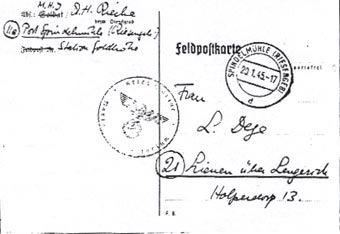 29.1.1945 - Feldpost card canc. Spindelmühle from Herbert Reiche in Ausbildungsstation "Goldhöhe" to wife of Dr. Wilhelm Dege. |
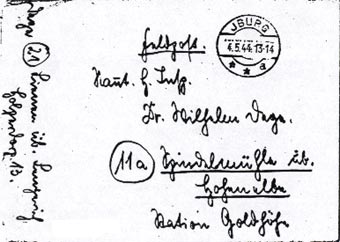 4.5.1944 - Feldpost cover canc. Jburg to Dr. Wilhelm Dege in Ausbildungsstation "Goldhöhe" by Spindelmühle. |
|
|
Training Station:
"Braunschweiger
Hütte" in Tirol.
|
|
|
|
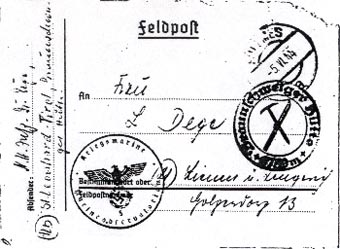 5.6.1944 - Feldpost lettercard canc. Fulpmes from Dr. Wilhelm Dege in Ausbildungsstation "Branschweiger", St. Leonhard im Pitztal, Tirol via Hochgebiegskampfschule Fulpmes. |
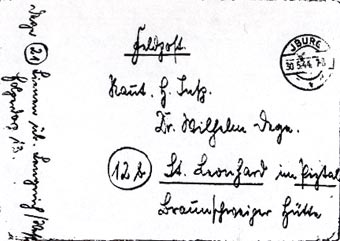 30.5.1944 - Feldpost cover canc. Jburg to Dr. Wilhelm Dege in Ausbildungsstation "Branschweiger", St. Leonhard im Pitztal, Tirol.
|
|
|
Naval Meteorological
School: "Gotenhafen".
|
|
|
|
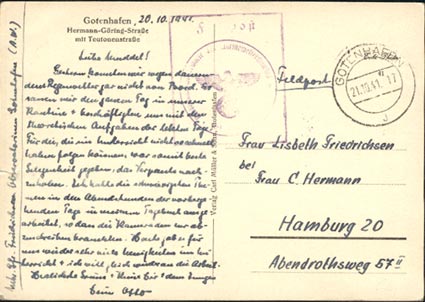 20.10.1941 - Feldpost postcard from Gfr. Otto Friderichsen - student at the Naval Meteorological School in Gotenhafen. Ausbildungswetterwarte. Sender: Observatorium Gotenhafen (A.W.) |
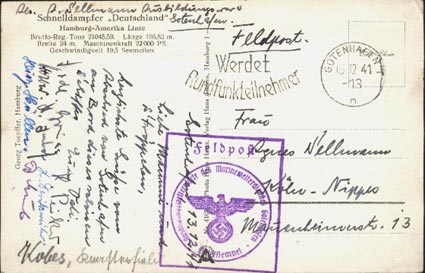 15.12.1941 - Feldpost postcard from Sellmann - student at the Naval Meteorological School in Gotenhafen. Ausbildungswetterwarte. Sender: Ausbildungswarte Gotenhafen |
|
|
Marineobservatorium:
"Greifswald".
|
|
|
|
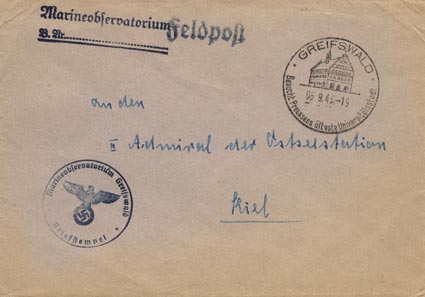 8.9.1943 - Official feldpost cover from the naval weather station: Marineobservatorium Greifwald to II Admiral der Ostseestation, Kiel. |
|
Marineobservatorium:
"Gotenhafen".
|
|
|
|
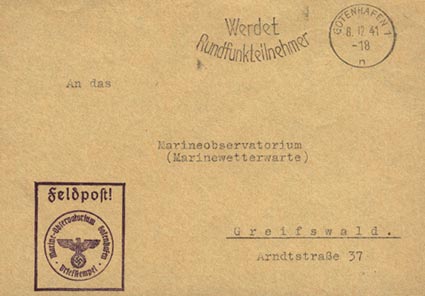 8.12.1941 - Official feldpost cover from the naval weather station: Marineobservatorium Gotenhafen to Marineobservatorium Greifswald. |
|
Marineobservatorium:
"Wilhelmshaven".
|
|
|
|
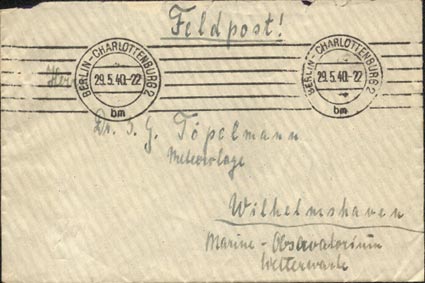 29.5.1940 - Feldpost cover canc. Berlin to Dr. Töpelmann, meteorolog at the naval weather station: Wilhelmshaven Marine-Observatorium - Wetterwarte. |
|
Marineobservatorium:
"Arbeitsgruppe Ralswiek" am Rügen.
|
|
|
|
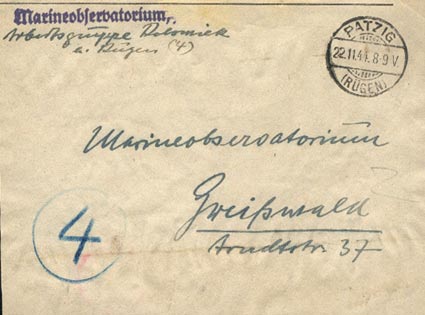 22.11.1944 - Official feldpost cover canc. Patzig (Rügen) from the naval weather station: Marineobservatorium Arbeitsgruppe Ralswiek to Marineobservatorium Greifswald. |
|
Meteorological Testing Unit of MWD |
|
|
|
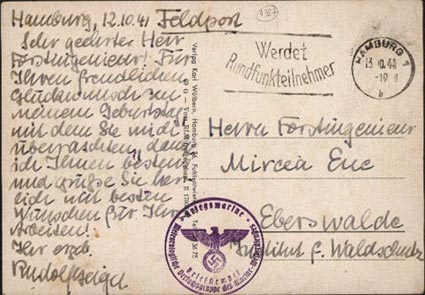 13.10.1941 - Feldpost card canc. Hamburg 1 from Rudolf Geiger at the naval testing unit of the naval weather service: Meteorologische Versuchsgruppe des Marine-Wetterdienstes. |
Back to
German forces
Update: 4.10.2015
Feedback: warcovers@adslhome.dk